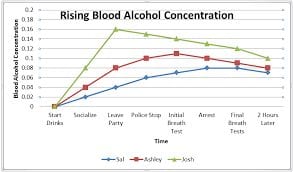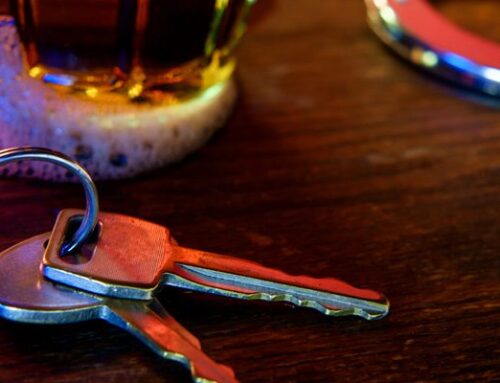Prosecutors like to use it. Occasionally, we may like it, too. Retrograde extrapolation is the method by which one estimates a person’s BAC at the time of driving based upon a chemical test result later in time. Swedish physician, Erik M.P. Widmark, first calculated absorption and elimination rates of alcohol in the body. Widmark created what we know today as the blood alcohol curve which represented the rise and fall of a person’s BAC as their body absorbs and eliminates alcohol.1 The rate of absorption, distribution, and elimination varies greatly between individuals and can have a substantial effect on someone’s intoxication and chemical test results. Prosecutors may use retrograde extrapolation to argue a person’s BAC at the time of driving exceeded the .08 legal limit based on a test minutes (or hours) after the stop. Conversely, the defense may posit an alternative explanation of the chemical test evidence. By using retrograde extrapolation they may endeavor to create reasonable doubt about whether the person’s BAC was under .08 at the time of driving. This is efficacious when the person looked sober on the video and the prosector’s “loss of normal use” theory is weak. Regardless of the objective, each retrograde extrapolation cross examination requires an understanding of important toxicological principles to execute the examination with best effect. Today we undertake to develop a simple guide to these principles to help the planning of your next retrograde extrapolation cross examination. The guide is intended as a starting point for those interested in becoming proficient in this area of trial practice. And like any area of trial advocacy, proficiency takes work, much time, and detailed independent study.
An essential library resource for the DWI trial attorney is a learned treatise from which to study these principles. My favorite is Garriott’s Medicolegal Aspects of Alcohol now in its 6th edition.2 Garriott’s is a multi-chaptered book authored by leaders in the field of forensic toxicology and alcohol pharmacology. Even more importantly, many of the State’s chemists and technical supervisors are familiar with Garriott’s and willingly concede it’s an authoritative treatise in their area of expertise. Further, they also concede many of the contributing authors are experts in their respective fields. This helps when you venture outside Garriott’s for authoritative sources published by a contributing author.
If we aspire to suppress the State’s use of retrograde extrapolation evidence then preserving error is the first step in developing an effective cross-examination. However, we’ll delay a discussion of error preservation until next month’s article since our toxicological guide will help use better understand the error preservation process. To put it briefly, preserving error may involve attacking the scientific theory of retrograde extrapolation, the technique applying the theory, and the theory’s application to our client’s case in particular. We also have opportunity to attack the expert witness themselves by challenging their ability to effectively communicate the science, the technique, its problems and pitfalls. Key cases for preserving error are Mata v. State, 122 S.W.3d 813 (Tex. Crim. App. 2003), Hartman v. State, 946 S.W.2d 60 (Tex. Crim. App. 1997), and Kelly v. State, 824 S.W.2d 568 (Tex. Crim. App. 1992). Rules of Evidence 401, 402, 403, 702, and 705 are instrumental, as well. Lastly, if you utilize retrograde extrapolation as exculpatory evidence then be prepared to respond to similar prosecution objections.
The position of a person’s BAC curve at the time of driving and at the time of chemical testing is critical as this will determine whether BAC increases, remains unchanged, or decreases after the actual driving incident.3 Consequently, the first question to consider in retrograde extrapolation is this . . . when did the person’s BAC peak? The time of peak BAC is important since any extrapolation depends upon whether the person was still absorbing alcohol into their system, at their peak, or were in the elimination phase at the time of the chemical test. Most DWI prosecutions involve a single breath or blood test result. Since a single test cannot determine when a person reached peak BAC, the time to peak BAC can only be inferred by knowledge of other critical facts. These facts may not be known by the State’s expert. Peak BAC and the time to peak after drinking stops depends on the rate of alcohol absorption. The general considerations are: (a) how much (and what) alcohol the person consumed; (b) over what time period the person drank (first and last drink times); and (c) gastric emptying.4 More specifically, the time to peak BAC depends on facts particular to the person on the day in question and include: (1) the presence and type of food in the stomach; (2) when the food was consumed; (3) the quantity of alcohol consumed; (4) the type of alcohol consumed; (5) the duration of drinking; and (6) time of the last drink; (7) the person’s mental state; (8) gender; (9) weight; (10) their typical drinking pattern; and (11) tolerance to alcohol.5 Generally, faster (and higher) peaks occur when moderate amounts of alcohol are consumed over a short period of time on an empty stomach (the chug-a-lug scenario). Conversely, slower (and lower) peaks occur when drinking is spread-out over a longer period of time and food is contemporaneously consumed (the typical social drinking pattern).6
When challenging the State’s expert on cross examination they should admit how important the time of peak BAC is to their retrograde extrapolation. Use leading questions to establish this point. Further, every conscientious expert should admit a single test result cannot determine where on the BAC curve your client was at test time. Consequently, they should also admit that without multiple tests results, specific individual characteristics about your client must be known to estimate the time of peak BAC. Depending upon the efficacy of the police investigation the expert often knows only the time of the stop, the time of the test, your client’s weight, and your client’s gender. They should also admit the fewer individual characteristics known to them the more speculative their retrograde extrapolation will be. Moreover, experts should also admit the longer the time between driving time and chemical test time the less reliable their extrapolation opinion. However, be aware that many State experts will opine that peak BAC occurs within one (1) hour of the last drink. However, the studies show the contrary. In fact, Dr. A.W. Jones has stated that “[m]ost subjects reach peak BAC within 60 minutes after the end of drinking but some required 120 minutes or more.7 The variable length of time to peak BAC is another factor casting doubt upon when your client reached maximum alcohol absorption. Once you’ve muddied the waters about the time to peak BAC the next attack follows.
If your client was still absorbing alcohol at the time of the chemical test, then retrograde extrapolation would show their BAC at driving time was lower. How much lower is, obviously, the key unknown. Retrograde extrapolation results, when testing during the absorption phase, depend on the absorption rate. Absorption rates are extremely variable and are rarely quoted in the research literature due to this variability. In brief, the rate is dependent upon the many individual characteristics about your client we examined above. Because of the many factors affecting absorption there are no “standard” rates. Again, the rate depends on the presence and type of food in the stomach since alcohol is absorbed from the stomach and small intestine by diffusion. Food in the stomach generally delays absorption as the alcohol remains in the stomach and is absorbed much more slowly. After passing into the small intestine absorption occurs quickly due to the intestine’s large surface area and rich blood supply. Generally, faster absorption rates occur when moderate amounts of alcohol are consumed on an empty stomach.8 In that scenario, the retrograde extrapolation would subtract a larger alcohol number (g/dL/hr) from the test time result. Slower rates occur when drinking is spread-out over longer periods of time.9 There, the retrograde extrapolation would subtract a smaller alcohol number (g/dL/hr) from the test time result. Since the State’s expert rarely knows how fast (or slow) your client was absorbing alcohol, the extrapolation numbers they use are speculative. But intuitively, we’d want the largest number possible subtracted from test time BAC.
If your client had reached peak BAC and were now eliminating alcohol at test time, then retrograde extrapolation would show their driving time BAC was higher. The expert would attempt to show this using “standard” elimination rates. In other words, they would add alcohol (g/dL/hr) to the test time result to obtain a driving time BAC. (it’s also possible that test time BAC might be the same as driving time BAC if the peak occurred between driving time and test time). A common elimination rate used by State experts is .15 g/dL/hr. However, the studies show elimination rates can vary anywhere between 0.08 g/dL/hr and 0.35 g/dL/hr.10 The most trustworthy method to determine your client’s elimination rate would be to follow their entire post-peak phase by taking repeated test samples and then perform a linear regression to determine the elimination rate. This, of course, is never done. Consequently, the expert should admit that elimination rates vary depending upon individual factors unknown to them. Don’t let them get away with using “average” rates of elimination (unless it helps you) since the expert has no idea whether your client is average, or not. Confront them with Garriott’s, or another treatise or study they consider authoritative on the subject, to show that research has proven that elimination rates can vary widely.
Measurement uncertainty is inherent in every scientific process. Although not directly applicable to retrograde extrapolation, it presents an interesting challenge to any extrapolation opinion. Measurement uncertainty relates to the range of values attributed to a single measured quantity. It’s important because no measurement can ever tell us what a quantity’s true value is. At best, the measuring system provides a range of values that has a known probability of containing the quantity’s value. Without stating measurement uncertainty, any conclusion based upon a measured result is speculation since there’s no way to understand what the result actually represents. (e.g., the Austin Crime Laboratory policy for reporting blood alcohol concentrations is with a 99.7% confidence level. The BAC is reported (+/-) 9.4%). Consequently, consider committing the State’s expert to expressing their extrapolation result in terms of a measurement confidence interval, for instance 99.7%. I doubt they will, though they may commit to “more likely than not.” If you had discussed the differences in burdens of proof at voir dire, the jury would be empowered to conclude just how speculative retrograde extrapolation really is.
Dr. Jones wrote that “requests to back extrapolate a person’s BAC from sample time to driving time is a dubious practice because of the many variables and unknowns involved.”11 He further stated that “[i]n a DWI trial, only a single measurement of BAC is usually available making it very difficult to engage in retrograde calculations with sufficient certainly for criminal prosecution.”12 But I liked Judge Johnson’s point in Mata the best: “Extrapolation back from the BAC at the time of testing to the BAC at the time of driving is an endeavor fraught with the danger of inappropriately bamboozling the jury into thinking that such an extrapolation can be anything close to accurate.” Mata v. State, 122 S.W.3d 813, 932 (Tex. Crim. App. 2003)(Johnson, J., concurring). Don’t let the prosecutor’s retrograde extrapolation bamboozle your next jury!
NOTES:
1. Widmark, E.M.P., Principles and applications of medicolegal alcohol determination, Biomedical Publications, Davis, 1981, pp. 1-163.
2. Garriott′s Medicolegal Aspects of Alcohol, 6th edition. Y.H. Caplan and B.A. Goldberger, Eds; Lawyers and Judges Publishing Company, Tucson, AZ, 2015.
3. Jones, A.W., Biochemical and Physiological Research on the Disposition and Fate of Ethanol in the Body, Garriott′s Medicolegal Aspects of Alcohol, p. 103 (James Garriott ed., 2008, 5th edition).
4. Id. at p. 94.
5. Id. at pp. 85-105; [See also Mata v. State, 122 S.W.3d 813, 908-09 (Tex. Crim. App. 2003)].
6. Id. at pp. 97-98.
7. Id. at p. 103. [See also, Dubowski, K.M., Absorption, Distribution and Elimination of Alcohol: Highway Safety Aspects, Journal of Studies on Alcohol, Supplement No. 10, July 1985, p. 99.]
8. Id. at p. 97.
9. Ibid.
10. Id. at p. 88, Table 3.7.
11. Id. at p. 127.
12. Ibid.
(“Off the Back” featured in the “Voice For The Defense” December 2016)
Stephen Gustitis is a criminal defense lawyer in Bryan-College Station. He is Board Certified in Criminal Law by the Texas Board of Legal Specialization. He is also a husband, father, and retired amateur bicycle racer.
“Off the Back” is an expression in competitive road cycling describing a rider dropped by the lead group who has lost the energy saving benefit of riding in the group’s slipstream. Once off the back the rider struggles alone in the wind to catch up. The life of a criminal defense lawyer shares many of the characteristics of a bicycle rider struggling alone, in the wind, and “Off the Back.” This column is for them.
Related Posts:
Challenging the Prosecution’s Forensic Evidence
Seven Ways a Criminal Attorney Can Help You
What Do You Do After a DWI Arrest?
How to Prepare the Perfect Cross Examination






